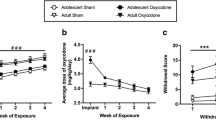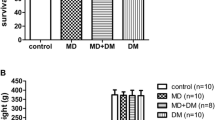Abstract
Abuse of opioids (mu-opioid agonists such as oxycodone) among parents during the gestation and early post-natal period is a concern for the long-term health of the offspring, beyond potential neonatal withdrawal symptoms. However, there is only limited information on such effects.
Objectives
We examined how prenatal, and early-post natal oxycodone exposure affected opioid addiction behaviors.
Methods
Adult male and female C57BL/CJ mice housed separately were first injected with ascending doses of oxycodone 1 time/day (1 mg/kg × 10 days, 1.5 mg/kg × 10 days, 2 mg/kg × 10 days, s.c.) whereas control mice were injected with saline. Newly formed parental dyads were then housed together and continued to receive ascending doses of oxycodone (3 mg/kg × 10 days, 4 mg/kg × 10 days, 5 mg/kg × 10 days, 6 mg/kg × 10 days or saline, s.c.) or saline during mating and gestation until the birth of the litter. The dams continued to receive oxycodone or saline through lactation, until F1 offspring were weaned. Upon reaching adulthood (12 weeks of age), male and female F1 offspring were examined in intravenous self-administration (IVSA) of oxycodone, on oxycodone-induced conditioned place preference (CPP) and oxycodone-induced antinociception.
Results
Adult F1 male and female offspring of parental dyads exposed to oxycodone self-administered more oxycodone, compared to offspring of control parental dyads. Ventral and dorsal striatal mRNA levels of genes such as Fkbp5 and Oprm1 were altered following oxycodone self-administration.
Conclusion
Prenatal and early post-natal oxycodone exposure enhanced oxycodone self-administration during adulthood in the C57BL/6 J mice.









Similar content being viewed by others
References
Ailes EC, Dawson AL, Lind JN, Gilboa SM, Frey MT, Broussard CS, Honein MA (2015) Opioid prescription claims among women of reproductive age–United States, 2008–2012. MMWR Morb Mortal Weekly Rep 64:37–41
Black A (2012) Breastfeeding the premature infant and nursing implications. Adv Neonatal Care 12:10–11. https://doi.org/10.1097/ANC.0b013e3182425ad6
Chiang YC et al (2015) Beneficial effects of co-treatment with dextromethorphan on prenatally methadone-exposed offspring. J Biomed Sci 22:19. https://doi.org/10.1186/s12929-015-0126-2
Clendeninn NJ, Petraitis M, Simon EJ (1976) Ontological development of opiate receptors in rodent brain. Brain Res 118:157–160. https://doi.org/10.1016/0006-8993(76)90852-0
Collins D, Reed B, Zhang Y, Kreek MJ (2016) Sex differences in responsiveness to the prescription opioid oxycodone in mice. Pharmacol Biochem Behav 148:99–105. https://doi.org/10.1016/j.pbb.2016.06.006
Collins D, Randesi M, da Rosa JC, Zhang Y, Kreek MJ (2018) Oprm1 A112G, a single nucleotide polymorphism, alters expression of stress-responsive genes in multiple brain regions in male and female mice. Psychopharmacology (Berl) 235:2703–2711. https://doi.org/10.1007/s00213-018-4965-x
Davis CP, Franklin LM, Johnson GS, Schrott LM (2010) Prenatal oxycodone exposure impairs spatial learning and/or memory in rats. Behav Brain Res 212:27–34. https://doi.org/10.1016/j.bbr.2010.03.022
Desai RJ, Hernandez-Diaz S, Bateman BT, Huybrechts KF (2014) Increase in prescription opioid use during pregnancy among Medicaid-enrolled women. Obstet Gynecol 123:997–1002. https://doi.org/10.1097/aog.0000000000000208
Devarapalli M, Leonard M, Briyal S, Stefanov G, Puppala BL, Schweig L, Gulati A (2016) Prenatal Oxycodone Exposure Alters CNS Endothelin Receptor Expression in Neonatal Rats Drug Res (Stuttg) 66:246-250https://doi.org/10.1055/s-0035-1569279
Everitt BJ, Belin D, Economidou D, Pelloux Y, Dalley JW, Robbins TW (2008) Review Neural mechanisms underlying the vulnerability to develop compulsive drug-seeking habits and addiction. Philos Trans R Soc Lond B Biol Sci 363:3125–3135. https://doi.org/10.1098/rstb.2008.0089. (2G5556313GX38610 [pii])
Fill MA, Miller AM, Wilkinson RH, Warren MD, Dunn JR, Schaffner W, Jones TF (2018) Educational Disabilities Among Children Born With Neonatal Abstinence Syndrome Pediatrics 142 https://doi.org/10.1542/peds.2018-0562
Glick SD, Strumpf AJ, Zimmerberg B (1977) Effect of in utero administration of morphine on the subsequent development of self-administration behavior. Brain Res 132:194–196. https://doi.org/10.1016/0006-8993(77)90720-x
Haight SC, Ko JY, Tong VT, Bohm MK, Callaghan WM (2018) Opioid Use Disorder Documented at Delivery Hospitalization - United States, 1999–2014. MMWR Morb Mortal Wkly Rep 67:845–849. https://doi.org/10.15585/mmwr.mm6731a1
Haight SC, Ko JY, Tong VT, Bohm MK, Callaghan WM MMWR Morbidity and mortality weekly report https://doi.org/10.15585/mmwr.mm6731a1
Hovious JR, Peters MA (1985) Opiate self-administration in adult offspring of methadone-treated female rats. Pharmacol Biochem Behav 22:949–953. https://doi.org/10.1016/0091-3057(85)90301-6
Kinnunen M, Kokki H, Hautajärvi H, Tuovinen K, Kokki M (2020) Oxycodone for pain management in the latent phase of labour - A pragmatic trial. Acta Anaesthesiol Scand 64:685–690. https://doi.org/10.1111/aas.13550
Kokki M et al (2012) Intravenous oxycodone for pain relief in the first stage of labour–maternal pharmacokinetics and neonatal exposure. Basic Clin Pharmacol Toxicol 111:182–188. https://doi.org/10.1111/j.1742-7843.2012.00884.x
Konijnenberg C, Sarfi M, Melinder A (2016) Mother-child interaction and cognitive development in children prenatally exposed to methadone or buprenorphine. Early Hum Dev 101:91–97. https://doi.org/10.1016/j.earlhumdev.2016.08.013
Koob GF, Volkow ND (2010) Neurocircuitry of addiction Neuropsychopharmacology : official publication of the American College of. Neuropsychopharmacology 35:217–238. https://doi.org/10.1038/npp.2009.110
Levran O et al (2014) Stress-related genes and heroin addiction: a role for a functional FKBP5 haplotype. Psychoneuroendocrinol 45:67–76. https://doi.org/10.1016/j.psyneuen.2014.03.017
Lind JN et al. (2017) Maternal Use of Opioids During Pregnancy and Congenital Malformations: A Systematic Review Pediatrics 139 https://doi.org/10.1542/peds.2016-4131
Martin RE et al. (2021) Maternal Oxycodone Treatment Results in Neurobehavioral Disruptions in Mice Offspring eNeuro 8 https://doi.org/10.1523/eneuro.0150-21.2021
McHugh RK, Nguyen MD, Chartoff EH, Sugarman DE, Greenfield SF (2021) Gender differences in the prevalence of heroin and opioid analgesic misuse in the United States, 2015–2019. Drug Alcohol Depend 227:108978. https://doi.org/10.1016/j.drugalcdep.2021.108978
Nguyen RHN et al (2002) (2023) Characteristics of Individuals in the United States Who Used Opioids During Pregnancy. J Women’s Health 32:161–170. https://doi.org/10.1089/jwh.2022.0118
Nygaard E, Moe V, Slinning K, Walhovd KB (2015) Longitudinal cognitive development of children born to mothers with opioid and polysubstance use. Pediatr Res 78:330–335. https://doi.org/10.1038/pr.2015.95
Nygaard E, Slinning K, Moe V, Walhovd KB (2017) Cognitive function of youths born to mothers with opioid and poly-substance abuse problems during pregnancy. Child Neuropsychol 23:159–187. https://doi.org/10.1080/09297049.2015.1092509
Odegaard KE et al (2020) Characterization of the Intergenerational Impact of in Utero and Postnatal Oxycodone Exposure. Transl Psych 10:329. https://doi.org/10.1038/s41398-020-01012-z
Pawluski JL, Lonstein JS, Fleming AS (2017) The Neurobiology of Postpartum Anxiety and Depression. Trends Neurosci 40:106–120. https://doi.org/10.1016/j.tins.2016.11.009
Piccotti L, Voigtman B, Vongsa R, Nellhaus EM, Rodriguez KJ, Davies TH, Quirk S (2019) Neonatal Opioid Withdrawal Syndrome: A Developmental Care Approach. Neonatal Netw 38:160–169. https://doi.org/10.1891/0730-0832.38.3.160
Porrino LJ, Smith HR, Nader MA, Beveridge TJ (2007) The effects of cocaine: a shifting target over the course of addiction. Prog Neuropsychopharmacol Biol Psychiatry 31:1593–1600. https://doi.org/10.1016/j.pnpbp.2007.08.040
Ramsey NF, Niesink RJ, Van Ree JM (1993) Prenatal exposure to morphine enhances cocaine and heroin self-administration in drug-naive rats. Drug Alcohol Depend 33:41–51. https://doi.org/10.1016/0376-8716(93)90032-l
Riley MA, Vathy I (2006) Mid- to late gestational morphine exposure does not alter the rewarding properties of morphine in adult male rats. Neuropharmacology 51:295–304. https://doi.org/10.1016/j.neuropharm.2006.03.022
Robinson TE, Berridge KC (1993) The neural basis of drug craving: an incentive-sensitization theory of addiction Brain research. Brain Res Rev 18:247–291. https://doi.org/10.1016/0165-0173(93)90013-p
Robinson SA, Jones AD, Brynildsen JK, Ehrlich ME, Blendy JA (2020) Neurobehavioral effects of neonatal opioid exposure in mice: Influence of the OPRM1 SNP. Addict Biol (5):e12806. https://doi.org/10.1111/adb.12806
Schlagal CR et al (2021) Maternal Opioid Exposure Culminates in Perturbed Murine Neurodevelopment and Hyperactive Phenotype in Adolescence. Neuroscience 463:272–287. https://doi.org/10.1016/j.neuroscience.2021.03.014
Seamans MJ et al (2018) Association of Household Opioid Availability and Prescription Opioid Initiation Among Household Members JAMA. Intern Med 178:102–109. https://doi.org/10.1001/jamainternmed.2017.7280
Shei A, Rice JB, Kirson NY, Bodnar K, Birnbaum HG, Holly P, Ben-Joseph R (2015) Sources of prescription opioids among diagnosed opioid abusers. Curr Med Res Opin 31:779–784. https://doi.org/10.1185/03007995.2015.1016607
Sithisarn T, Legan SJ, Westgate PM, Wilson M, Wellmann K, Bada HS, Barron S (2017) The Effects of Perinatal Oxycodone Exposure on Behavioral Outcome in a Rodent Model. Front Pediatr 5:180. https://doi.org/10.3389/fped.2017.00180
Smith CJ et al (2022) Prenatal opioid exposure inhibits microglial sculpting of the dopamine system selectively in adolescent male offspring. Neuropsychopharmacology 47:1755–1763. https://doi.org/10.1038/s41386-022-01376-4
Sparks AC, Radakrishnan S, Corry NH, McDonald D, Carlson K, Carballo CE, Stander V (2021) Associations between Spouse and Service Member Prescriptions for High-Risk and Long-Term Opioids: A Dyadic Study. Addict Behav Rep 14:100364. https://doi.org/10.1016/j.abrep.2021.100364
Sutter MB, Leeman L, Hsi A (2014) Neonatal opioid withdrawal syndrome. Obstet Gynecol Clin North Am 41:317–334. https://doi.org/10.1016/j.ogc.2014.02.010
Wachman EM et al (2013) Association of OPRM1 and COMT single-nucleotide polymorphisms with hospital length of stay and treatment of neonatal abstinence syndrome. Jama 309:1821–1827. https://doi.org/10.1001/jama.2013.3411
Wachman EM, Hayes MJ, Lester BM, Terrin N, Brown MS, Nielsen DA, Davis JM (2014) Epigenetic variation in the mu-opioid receptor gene in infants with neonatal abstinence syndrome. J Pediatr 165:472–478. https://doi.org/10.1016/j.jpeds.2014.05.040
Wachman EM, Hayes MJ, Sherva R, Brown MS, Davis JM, Farrer LA, Nielsen DA (2015) Variations in opioid receptor genes in neonatal abstinence syndrome. Drug Alcohol Depend 155:253–259. https://doi.org/10.1016/j.drugalcdep.2015.07.001
Wachman EM, Schiff DM, Silverstein M (2018) Neonatal Abstinence Syndrome: Advances in Diagnosis and Treatment. Jama 319:1362–1374. https://doi.org/10.1001/jama.2018.2640
Yazdy MM, Mitchell AA, Tinker SC, Parker SE, Werler MM (2013) Periconceptional use of opioids and the risk of neural tube defects. Obstet Gynecol 122:838–844. https://doi.org/10.1097/AOG.0b013e3182a6643c
Yohn NL, Bartolomei MS, Blendy JA (2015) Multigenerational and transgenerational inheritance of drug exposure: The effects of alcohol, opiates, cocaine, marijuana, and nicotine. Prog Biophys Mol Biol 118:21–33. https://doi.org/10.1016/j.pbiomolbio.2015.03.002
Zannas AS, Wiechmann T, Gassen NC, Binder EB (2016) Gene-Stress-Epigenetic Regulation of FKBP5: Clinical and Translational Implications. Neuropsychopharmacology 41:261–274. https://doi.org/10.1038/npp.2015.235
Zhang Y, Mantsch JR, Schlussman SD, Ho A, Kreek MJ (2002) Conditioned place preference after single doses or “binge” cocaine in C57BL/6J and 129/J mice. Pharmacol Biochem Behav 73:655–662
Zhang Y, Picetti R, Butelman ER, Schlussman SD, Ho A, Kreek MJ (2009) Behavioral and neurochemical changes induced by oxycodone differ between adolescent and adult mice. Neuropsychopharmacology 34:912–922. https://doi.org/10.1038/npp.2008.134
Zhang Y, Picetti R, Butelman ER, Ho A, Blendy JA, Kreek MJ (2015) Mouse model of the OPRM1 (A118G) polymorphism: differential heroin self-administration behavior compared with wild-type mice. Neuropsychopharmacol 40:1091–1100. https://doi.org/10.1038/npp.2014.286
Zhang Y, Windisch K, Altschuler J, Rahm S, Butelman ER, Kreek MJ (2016) Adolescent oxycodone self administration alters subsequent oxycodone-induced conditioned place preference and anti-nociceptive effect in C57BL/6J mice in adulthood. Neuropharmacol 111:314–322. https://doi.org/10.1016/j.neuropharm.2016.09.005
Zhang Y, Liang Y, Randesi M, Yuferov V, Zhao C, Kreek MJ (2018) Chronic Oxycodone Self-administration Altered Reward-related Genes in the Ventral and Dorsal Striatum of C57BL/6J Mice: An RNA-seq. Anal Neurosci 393:333–349. https://doi.org/10.1016/j.neuroscience.2018.07.032
Acknowledgements
Dr. Miriam and Sheldon G. Adelson Medical Research Foundation (MJK)
Author information
Authors and Affiliations
Corresponding author
Ethics declarations
Conflict of Interest
On behalf of all authors, the corresponding author states that there is no conflict of interest.
Additional information
Publisher's Note
Springer Nature remains neutral with regard to jurisdictional claims in published maps and institutional affiliations.
Rights and permissions
Springer Nature or its licensor (e.g. a society or other partner) holds exclusive rights to this article under a publishing agreement with the author(s) or other rightsholder(s); author self-archiving of the accepted manuscript version of this article is solely governed by the terms of such publishing agreement and applicable law.
About this article
Cite this article
Zhang, Y., Butelman, E.R. & Kreek, M.J. Effect of prenatal and early post-natal oxycodone exposure on the reinforcing and antinociceptive effects of oxycodone in adult C57BL/6 J mice. Psychopharmacology 241, 359–377 (2024). https://doi.org/10.1007/s00213-023-06493-6
Received:
Accepted:
Published:
Issue Date:
DOI: https://doi.org/10.1007/s00213-023-06493-6




